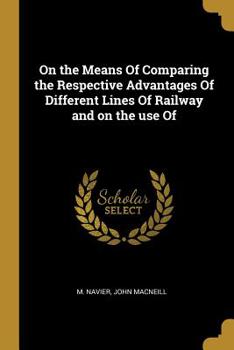On the Means Of Comparing the Respective Advantages Of Different Lines Of Railway and on the use Of
This work has been selected by scholars as being culturally important, and is part of the knowledge base of civilization as we know it. This work was reproduced from the original artifact, and remains as true to the original work as possible. Therefore, you will see the original copyright references, library stamps (as most of these works have been housed in our most important libraries around the world), and other notations in the work.
This work is in the public domain in the United States of America, and possibly other nations. Within the United States, you may freely copy and distribute this work, as no entity (individual or corporate) has a copyright on the body of the work.
As a reproduction of a historical artifact, this work may contain missing or blurred pages, poor pictures, errant marks, etc. Scholars believe, and we concur, that this work is important enough to be preserved, reproduced, and made generally available to the public. We appreciate your support of the preservation process, and thank you for being an important part of keeping this knowledge alive and relevant.
Related Subjects
HistoryCustomer Reviews
Rated 4 starsGreat introduction, but not for everybody
First of all, this book is not for everybody. It's not for the pop-science reader, it contains far too much mathematics to be of any use for him. It's not for the professional scientist seeking in-depth understanding either. If you are either type of reader, you're better off reading something else. Every book has its readership target, and this book found one appreciative reader in this reviewer. I have a background...
0Report
Rated 4 starsreview string theory demystified
The book is interesting. Very good for an overall view of the subject, but it has to be taken carefully, since if one wants to say that "knows" string theory, this book alone will not give that. But if you are from another field (e.g. experimental nuclear physics) just trying to understand what this theory is all about, then the book is perfect.
0Report
Rated 5 starsA playful yet serious textbook on string theory
I actually love the book, its format, and its focus. Imagine that your task is to take Polchinski's textbook on String Theory and compress both volumes to 320 light pages or so. You have to include some basics of GR, QFT, abstract classical mechanics but also the CFTs, bosonic strings, light cone gauge, T-duality, symmetries, RNS superstring, heterotic strings, D-branes, AdS/CFT, black holes. But you also add some material...
0Report













